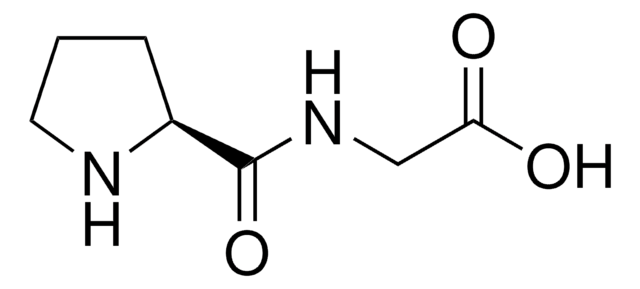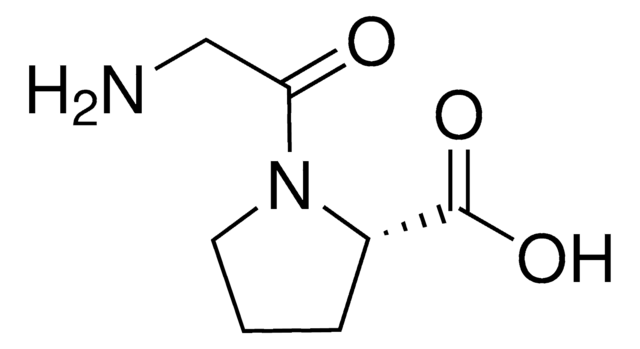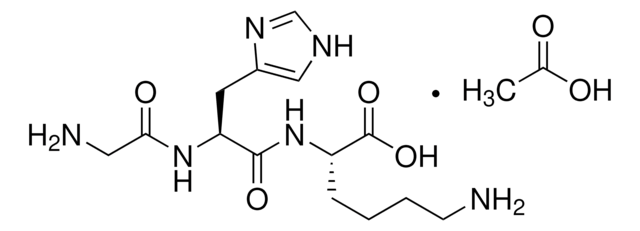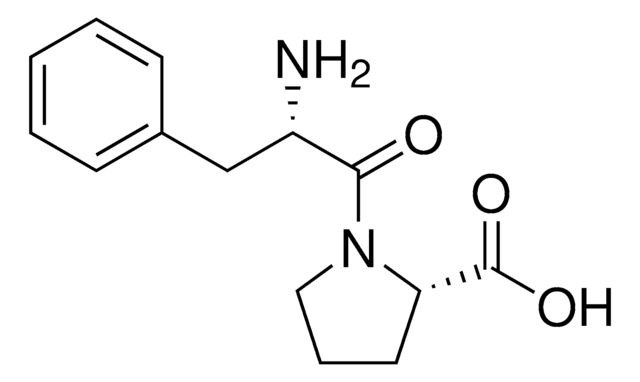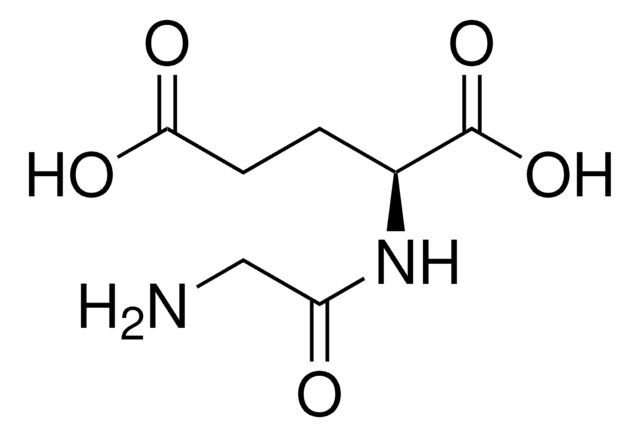すべての画像(1)
About This Item
実験式(ヒル表記法):
C12H19N3O6
CAS番号:
分子量:
301.30
MDL番号:
UNSPSCコード:
12352209
PubChem Substance ID:
NACRES:
NA.32
おすすめの製品
品質水準
アッセイ
≥98% (HPLC)
フォーム
powder
色
white
保管温度
−20°C
SMILES記法
NCC(=O)N1CCC[C@H]1C(=O)N[C@@H](CCC(O)=O)C(O)=O
InChI
1S/C12H19N3O6/c13-6-9(16)15-5-1-2-8(15)11(19)14-7(12(20)21)3-4-10(17)18/h7-8H,1-6,13H2,(H,14,19)(H,17,18)(H,20,21)/t7-,8-/m0/s1
InChI Key
JJGBXTYGTKWGAT-YUMQZZPRSA-N
詳細
IGF1 (insulin-like growth factor 1) protein is cleaved into des-N-(1-3)-IGF-1 and an N-terminal Gly-Pro-Glu (GPE tripeptide). It is thought to be an outcome of specific neural processing.
生物化学的/生理学的作用
Gly-Pro-Gluは、神経保護物質であり、IGF-1のN末端のトリペプチドです。Gly-Pro-Gluは、ハンチントン病、パーキンソン病、アルツハイマー病といった神経変性疾患モデル動物に中枢投与すると神経保護作用を示し、急性脳損傷のモデル動物でも変化を及ぼしています。この神経保護活性と、グルタミン酸受容体に対する親和性とは関係していません。GPEは、カルシウムやグリコーゲンシンターゼキナーゼ3βのシグナル伝達を調節するβ-アミロイドクリアランスには依存しないメカニズムを通じ、ソマトスタチン系に対してインスリン様成長因子Iと似た作用を示すことが、知見によって示唆されています。
Gly-Pro-Glu (GPE) is a neuroactive peptide and prevents the binding of glutamate to N-methyl-D-aspartate (NMDA) receptor. It positively regulates the potassium-mediated release of acetylcholine from rat cortical slices. Thus, it is involved in the control of brain function. In vitro studies show that this peptide confers neuroprotection to CA1-2 hippocampal neurons against excitotoxic insult.
保管分類コード
11 - Combustible Solids
WGK
WGK 3
引火点(°F)
Not applicable
引火点(℃)
Not applicable
適用法令
試験研究用途を考慮した関連法令を主に挙げております。化学物質以外については、一部の情報のみ提供しています。 製品を安全かつ合法的に使用することは、使用者の義務です。最新情報により修正される場合があります。WEBの反映には時間を要することがあるため、適宜SDSをご参照ください。
Jan Code
G3923-50MG:
G3923-BULK:
G3923-VAR:
G3923-10MG:
最新バージョンのいずれかを選択してください:
T Alexi et al.
Experimental neurology, 159(1), 84-97 (1999-09-16)
Huntington's disease is an incurable genetic neurological disorder characterized by the relatively selective degeneration of the striatum. Lesioning of the striatum in rodents using the excitatory amino acid agonist, quinolinic acid (QA), effectively mimics the human neuropathology seen in Huntington's
J Saura et al.
Neuroreport, 10(1), 161-164 (1999-03-27)
Insulin-like growth factor 1 (IGF-1) plays a critical role in CNS development. IGF-1 can block neuronal apoptosis in vitro and in vivo. IGF-1 is thought to be cleaved into des-N-(1-3)-IGF-1 and an amino terminal glycine-proline-glutamate (GPE tripeptide). Here we report
Chih-Wei Chang et al.
European journal of drug metabolism and pharmacokinetics, 42(2), 239-249 (2016-04-28)
Resveratrol (3,4',5-trihydroxy-trans-stilbene; RES) produces a variety of pharmacological effects; however, its oral bioavailability (BA) approaches zero. In this study, grape peel extract (GPE) was incorporated into a solid dispersion delivery system to improve the solubility, dissolution and oral absorption of
Maxwell Mewa-Ngongang et al.
Foods (Basel, Switzerland), 8(2) (2019-02-06)
Microbial spoilage causes food losses in the food industry and as such, the use of synthetic chemical preservatives is still required. The current study proposes the use of agro-waste, i.e., grape pomace extracts (GPE), as production medium for biopreservation compounds.
Max Jakobsson et al.
BMC musculoskeletal disorders, 20(1), 137-137 (2019-04-01)
Physical capacity tasks are useful tools to assess functioning in patients with low back pain (LBP), but evidence is scarce regarding the responsiveness (ability to detect change over time) and minimal important change (MIC). The aim was to investigate the
ライフサイエンス、有機合成、材料科学、クロマトグラフィー、分析など、あらゆる分野の研究に経験のあるメンバーがおります。.
製品に関するお問い合わせはこちら(テクニカルサービス)